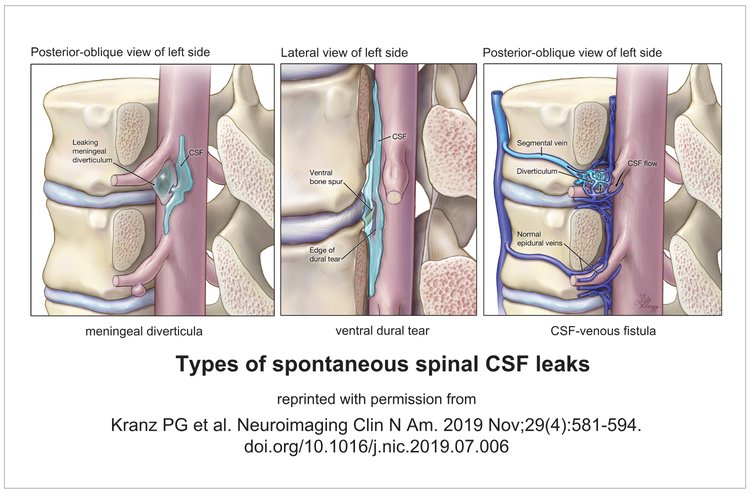Causes
What Causes a Spinal CSF Leak?
There are several known causes of intracranial hypotension (low volume of cerebrospinal fluid in the head) due to spinal CSF leak. Below, we discuss iatrogenic, traumatic, and spontaneous leaks.
Iatrogenic: Caused by a medical procedure
The most common cause of a spinal CSF leak is lumbar puncture, and the headache caused by a spinal CSF leak due to lumbar puncture is referred to as a Post–Dural Puncture Headache (PDPH). Often, the lumbar dura mater is intentionally punctured for various diagnostic and therapeutic reasons. One example would be a diagnostic lumbar puncture (LP) for a patient thought to have meningitis, to analyze and culture the cerebrospinal fluid. Another would be a lumbar puncture for injection of contrast for a type of spinal imaging known as myelography. Another common therapeutic reason would be spinal anesthesia. Most often these intentionally placed holes heal over quickly, but in some cases, they do not. We know that there is a lower risk of PDPH when the procedure is performed by more experienced clinicians, when smaller needles are used, and when a less traumatic type of lumbar puncture (LP) needle (pencil-point vs sharp) is used.
Dural tears may occur inadvertently at the time of epidural injections. (Epidural space is in the spinal canal outside of dura and spinal cord)
They may occur at the time of spinal or other surgery.
CSF shunt over-drainage may also cause intracranial hypotension.
Chiropractic or other spinal manipulation has been reported as another cause of spinal CSF leak.
Traumatic: Caused as a result of an injury
Traumatic leaks have been reported in association with brachial plexus injuries, spinal injuries, sports injuries, and falls.
Spontaneous: Occurring with minimal or no clear precipitant
Spontaneous leaks appear seemingly out of nowhere. Common reported events or mechanical factors associated with the onset of symptoms include lifting small or large items, straining, stretching, positional changes, sporting activities, roller coaster rides, and falls. Some of these might also be categorized as traumatic.
Spontaneous spinal CSF leaks may be associated with spinal pathology such as calcified disc material or bone spurs. These leaks are usually ventral, or in front of the spinal cord.
Spontaneous leaks may also be associated with preexisting weakness of the dura mater. A range of dural defects have been reported at surgery, and electron microscopy of dura has revealed abnormalities in a substantial proportion of cases. Heritable Disorders of Connective Tissue (HDCT) occur at a higher frequency in people affected by spinal CSF leak; intracranial hypotension may be the first noted manifestation. Marfan syndrome, Ehlers-Danlos syndrome (both classic and hypermobility type), and Unspecified Heritable Disorders of Connective Tissue have been reported. Patients with spontaneous spinal CSF leaks have been shown to have higher risk of intracranial aneurysms, bicuspid aortic valve, and thoracic aortic aneurysms, and should be evaluated for HDCT.
Spontaneous leaks may also be caused by CSF-venous fistula, an abnormal connection between the normal space containing CSF and veins outside the dura mater. How these develop is not yet understood.
Spontaneous spinal CSF leaks are uncommon, but not rare. One estimate of annual incidence is 5 in 100,000, however this has not been well-studied. Unfortunately, misdiagnoses and delayed diagnoses are common in this subset.
Types of Spontaneous Spinal CSF Leaks
This image illustrates several kinds of spontaneous spinal CSF leaks: On the left we see a leak due to a meningeal diverticula (the small, bulging pouch on the meninges); in the center we see a leak due to a bone spur; and on the right, we see a leak due to CSF-venous fistula.

